-
Car Reviews
- All reviews
- Midsize SUVs
- Small cars
- Utes
- Small SUVs
- Large SUVs
- Large cars
- Sports SUVs
- Sports cars
- Vans
Latest reviews
- Car News
-
Car Comparisons
Latest comparisons
- Chasing Deals
Years in the making, Volkswagen now has an affordable version of the T-Roc small SUV available in Australia. There’s much to like – but the 110TSI Style isn’t perfect.
Half way through last year, Volkswagen finally introduced the T-Roc small SUV into the Australian market. Hugely popular in Europe, the T-Roc is more or less Golf sized, but unlike this brand’s classic hatch, the T-Roc wears a pumped-up crossover aesthetic outside.
The only problem was there was just one model: the $40,490 T-Roc 140TSI Sport which, thanks to its turbo two-litre engine and all-wheel-drive system, is something like a cladded and all-paw Golf GTI.
Now, there’s a more affordable 2021 T-Roc on the block. But far from ushering in a boggo base model, the $33,990 Volkswagen T-Roc 110TSI Style brings an impressive engine to the table and pretty generous standard equipment.
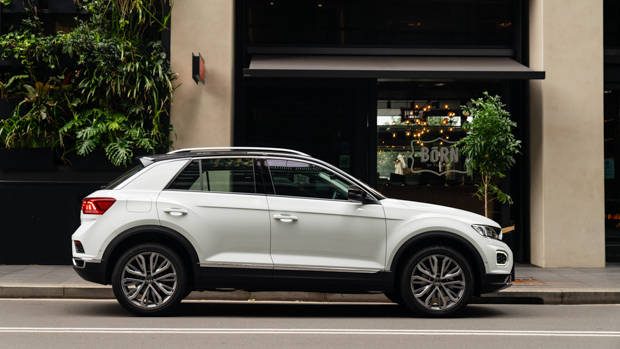
That starts outside, where Volkswagen have dodged any desire to give this car dressed-down looks. Big 18-inch wheels are standard, as is a contrast black roof. In fact, you’ll see gloss black applied to the mirrors, pillars, grille and rear spoiler, accented with elegant splashes of chrome, here and there.
While the T-Roc 110TSI is $6,500 cheaper than the 140TSI, which continues on in the range, it doesn’t look cheap. Instead, it’s a classy looking small crossover that immediately fits in.
That said, there are key differences between this new, entry-level T-Roc and its faster, more sophisticated 140TSI sibling. So, which T-Roc is best for you?
If you’re moving up and out of a late-model Volkswagen Golf, the new T-Roc 110TSI will feel very familiar.
That’s essentially what the T-Roc is all about. It’s the Golf of SUVs. It’s about the same size as Volkswagen’s famous hatchback, but you sit a little higher – and of course, the T-Roc wears a more rugged and extroverted design outside.
Similarities to the Golf extend to the T-Roc’s engine, which is common to the pair. It’s a 1.4-litre turbocharged four-cylinder petrol engine producing 110kW of power and 250Nm of torque. That engine has been doing duty in the Golf 110TSI for years, and it’s a motor we know and love.
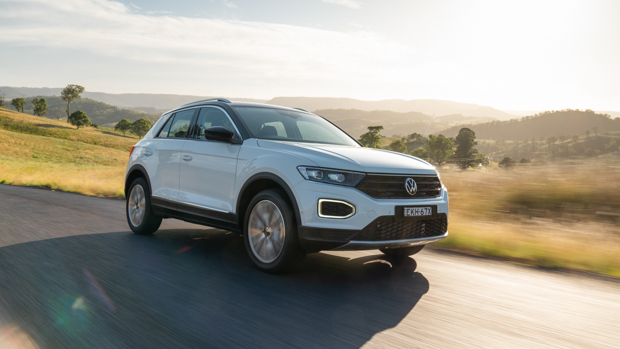
Torquier, more refined and more efficient than most rivals, the 1.4-litre strikes the right balance between frugality and punch, making it suitable for driving in the city and in the country, especially as the front-wheel-drive T-Roc 110TSI weighs only 1,319kg. It’s 150kg lighter than the faster, all-wheel-drive T-Roc 140TSI.
However, it’s worth noting that European buyers get a newer and even more frugal 1.5-litre turbo engine. The outputs are the same, but the 1.5-litre ‘TSI Evo’ motor uses less fuel. Plus, the 1.5-litre has a particulate filter to lessen emissions. Australia’s high-sulphur petrol would clog this filter, and Volkswagen do not have a workaround they are prepared to use on popular models like the Golf and T-Roc – at least not yet.
So Australia has been assigned an ‘old’ engine that works with our fuel. We want you to understand that this is still a great engine, but it’s no longer the newest technology.
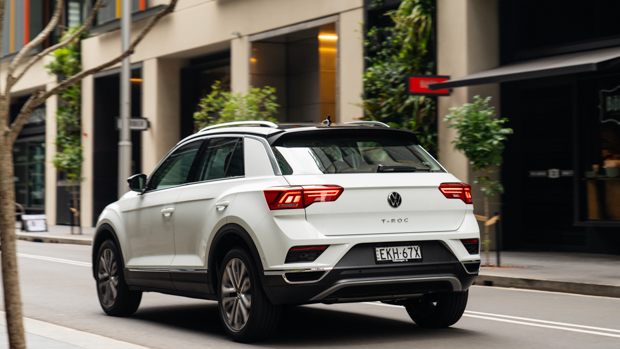
The T-Roc’s dual-clutch automatic ‘DSG’ gearbox is a casualty of this decision as well. A quick-shifting DSG is still used on the T-Roc 140TSI, but the new 110TSI gets an eight-speed torque converter automatic instead.
Some would have cheered the adoption of a conventional auto in a Volkswagen five years ago, but it’s a backward step now. This is not a very crisp or slick transmission: it’s VW’s ‘B-team’ gearbox. Volkswagen have refined their DSGs so much that they are now the smoother gearbox in these cars – but VW now refuse to pair an old engine with their latest transmissions.
Still, after a while, you stop expecting the T-Roc to behave like it has a crisp DSG and you accept the reasonably-witted auto. It’s fine. And the engine still impresses.
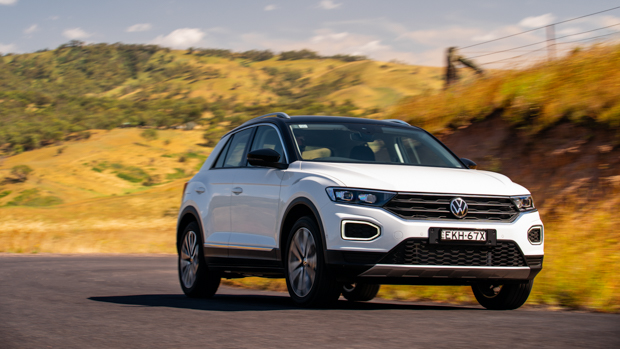
On the ride and handling front, the T-Roc 110TSI is good – but not great. This more affordable variant ditches the multi-link independent rear suspension system of the T-Roc 140TSI Sport and adopts a more rudimentary torsion beam at the back.
While the T-Roc’s ride quality is acceptable, there is a noticeable disjoint between the supple front suspension and the less capable rear suspension. On a smooth or undulating road you don’t feel it, but traverse a pothole – or especially an expansion joint – and the rear suspension thumps across it. This makes a booming noise and it jarrs the cabin.
Rivals like the Toyota C-HR demonstrate how independent rear suspension allows a more supple ride and handling balance, while competitors that also go the cheap route – like the Mazda CX-30 – suffer from similar loud and jarring performance over bumps and joints.
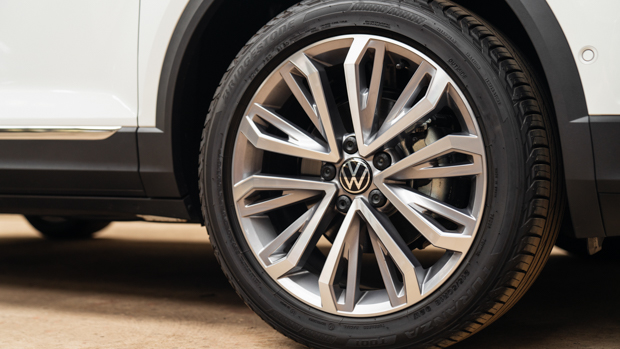
Upgraded rear suspension is a good reason to strongly consider spending an extra $6,500 on the T-Roc 140TSI Sport, which is better in every way. The 140TSI rides quite impeccably, plus it’s considerably quicker thanks to its 140kW/320Nm two-litre turbo, AWD, and dual-clutch automatic combination. Later, a circa-$60k T-Roc R sports SUV will likely join the range, too.
The 110TSI steers well, though, with a crisp and intuitive electric power steering tune that makes parking a doddle at low speed before building effort when you’re tackling a fast and flowing country road. The fact the 110TSI is 150kg lighter than the 140TSI helps its cause, too.
Volkswagen’s decision to equip the 110TSI Style with big, good-looking 18-inch wheels hasn’t really harmed the ride or refinement. It’s the rudimentary rear suspension that causes those problems. Notably, the outgoing Golf Mk 7 was never offered in Australia with a torsion beam rear suspension: only with a superior independent setup.
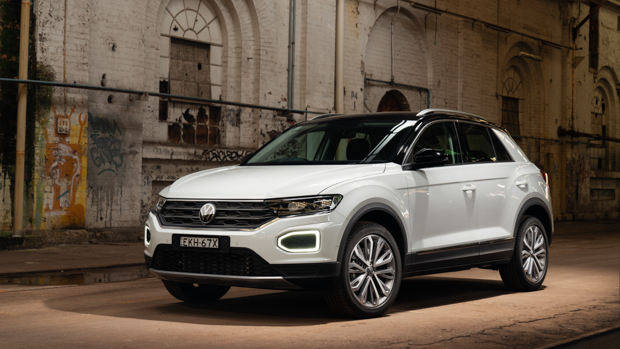
We appreciate that Volkswagen has decided to equip both T-Roc models, including this more affordable entry grade, with its full IQ Drive advanced safety suite. No safety features are relegated to the options list.
Safety kit starts with six airbags and a good autonomous emergency braking (AEB) system. The high-speed forward radars detect cars and pedestrians (but notably not cyclists). There is standard reversing AEB, which we have independently tested. Reversing AEB can avoid collisions with people and cars while reversing.
Strong lane centring is also standard, along with blind spot monitoring and rear cross-traffic alert. You get driver fatigue detection, front and rear parking sensors, a reversing camera (which is too grainy in our opinion), and a low tyre pressure warning system.
The T-Roc’s interior is a two-sided tale. There’s how it works, and then there’s what it’s made of.
Like almost every Volkswagen currently on sale, the T-Roc’s cabin is a triumph of handsome function-forward design. Almost every function works intuitively and is where you’d expect it. Important controls like the fan speed, temperature and volume all have dedicated knobs.
Just like a Golf, then. Well, not quite.
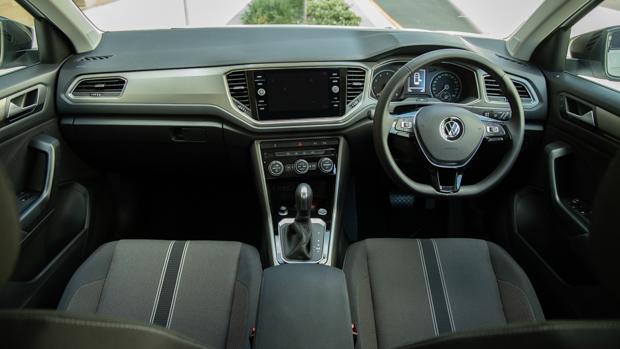
While a Golf has generous, plush interior materials, covering the dashboard in soft and yielding plastics, the T-Roc offers up what feels like acres of hard, reflective plastic with no give.
While Volkswagen’s staple leather steering wheel and gear shifter remain, along with a soft centre armrest, virtually every other surface in this car feels built to a price.
That is a stark departure for a brand that was once regarded as unbeatable for perceived quality in mainstream cars. It’s a trend we’ve observed for a couple of years, and it’s a worrisome development for Volkswagen.
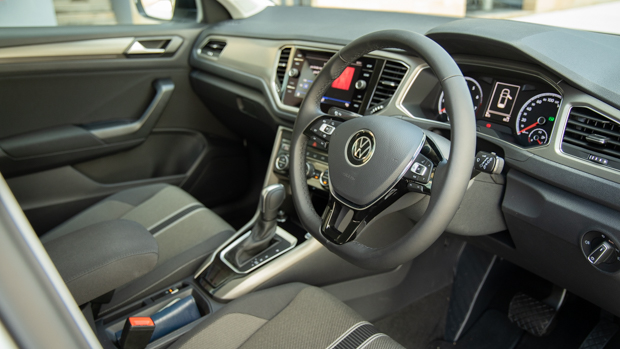
At least the seats retain VW’s classic firm-but-supportive character, though no electric adjustment of any kind is available. Instead, the T-Roc has shapely and comfortable seats with manual movements. There is adjustable lumbar on the standard cloth seats.
Tick the box for the Luxury Package ($3,800) and along with a panoramic sunroof and power tailgate, the seats are swapped out for ‘Comfort Sport’ pews from the T-Roc 140TSI model. These have taller bolsters, though the heated Vienna leather-appointed upholstery feels cheaper, and more like vinyl, than we’re used to in a hide-lined Volkswagen…
For anybody that’s owned a Volkswagen in the last few years, the T-Roc’s infotainment will also be easy to learn, because it hasn’t changed much.
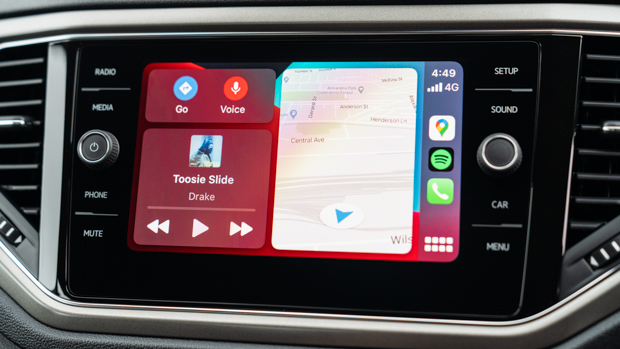
Driven through a snappy eight-inch touchscreen, the media functions are easy to navigate and even the base six-speaker stereo sounds good. In base form, the $33,990 T-Roc Style packs wired Apple CarPlay and wired Android Auto, but there’s no integrated navigation or digital radio.
Navigation can be added via the $2,000 Sound and Vision package – though Volkswagen have changed their nav software and it’s now unnecessarily more cumbersome to operate.
The Sound and Vision package is worthwhile though: $2k is a reasonable price for an upgrade that takes in wireless CarPlay and Android Auto, plus you get a great eight-speaker Beats stereo and a 10.25-inch digital instrument cluster that is bright and clear. The pack only really misses wireless charging, which we feel is necessary if you’re going to have wireless CarPlay.
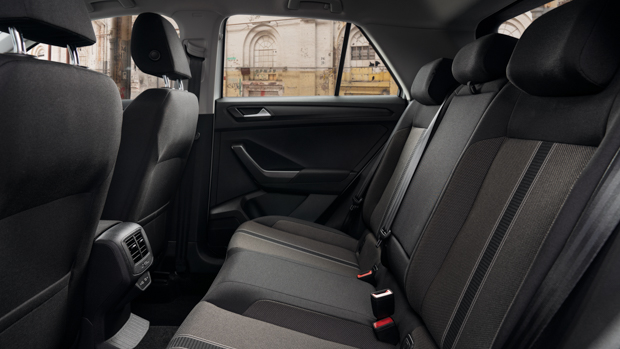
Pleasingly, proximity start and entry to the front doors is standard, as is LED lighting all round – headlights, indicators, and interior lighting.
Standard spec also takes in basics like four USB-C ports, four cupholders, dual-zone climate control, a hidden drawer under the driver’s seat, armrests front and back, and air vents in the rear. The back seats are also spacious enough for six-foot adults. The T-Roc is a well-sized SUV.
Equally, the boot space, which measures 445 litres, is more spacious than the all-wheel-drive 140TSI Sport. There’s a variable load floor that goes impressively deep, plus shopping bag hooks. The rear seats fold in a 60/40 split to reveal 1,290 litres of space in two-seat mode.
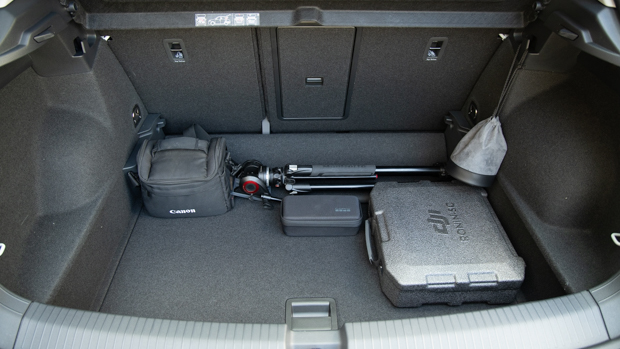
The Volkswagen T-Roc 110TSI is reasonably affordable to run, largely thanks to its reasonably frugal fuel economy compared to other small SUVs.
VW claims that the 1.4-litre engine in the T-Roc Style consumes 6.2L/100km. Our testing revealed that the real-world consumption was 7.5L/100km – but that’s good for the class, and especially so given the torque on offer.
That being said, like other Volkswagens, the T-Roc asks you to fill it up with at least 95RON premium fuel which is pricier than ordinary unleaded.
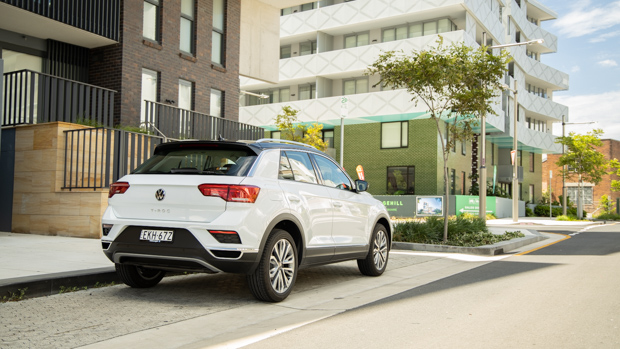
Servicing the T-Roc by the logbook means visiting the dealer every year or 15,000 kilometres – whichever interval comes first.
You can save money on servicing by purchasing an up-front service pack, which Volkswagen says represents a decent discount. This pack costs $1,300 for three years / 45,000km (averaging $433 per service for three visits), or $2,100 for five years / 75,000km (averaging $420 per visit).
That said, it’s worth keeping in mind that some rivals are substantially cheaper to maintain. The Toyota C-HR 1.2-litre turbo costs $200 per 12 month/15,000km service for the first four visits.
The Volkswagen T-Roc is covered by VW’s five year, unlimited kilometre warranty that also includes a year of roadside assistance.
The Volkswagen T-Roc 110TSI Style is a thoughtful addition to the VW stable. Considerably more affordable than the hot 140TSI version, the T-Roc 110TSI gives people who would once have purchased a Golf a reasonably affordable small SUV alternative.
The T-Roc continues to demonstrate a commitment to functional interior design, smart sizing and great packaging, and the standard fitment of so many well-calibrated safety features scores points with us.
But there is meaning to the T-Roc 110TSI that goes beyond a simple review of a particular small SUV.
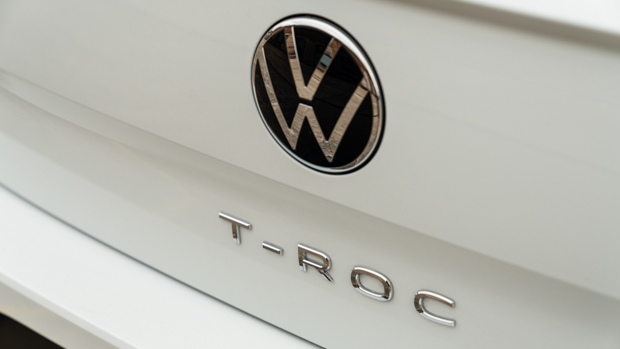
Volkswagen appears to be walking away from features once regarded as sacred cows – plush interior materials, independent rear suspensions, and cutting-edge European-spec engines and gearboxes.
The powertrain decisions are attributable to Australia’s embarrassingly low-quality, high-sulphur petrol – but Volkswagen has to accept some responsibility for opting out of engineering new solutions that would fit the constraints of the Australian market.
These decisions might solidify into trends with the imminent release of the critical Golf Mk 8 small car. We await the new generation of Volkswagen’s archetypal small car with a mix of interest and trepidation.
Variant tested 110TSI Style
Key specs (as tested)
About Chasing cars
Chasing Cars reviews are 100% independent.
Because we are powered by Budget Direct Insurance, we don’t receive advertising or sales revenue from car manufacturers.
We’re truly independent – giving you Australia’s best car reviews.
The estimate provided does not take into account your personal circumstances but is intended to give a general indication of the cost of insurance, in order to obtain a complete quote, please visit www.budgetdirect.com.au. Estimate includes 15%^ online discount.
^Conditions Apply
Budget Direct Insurance arranged by Auto & General Services Pty Ltd ACN 003 617 909(AGS) AFSL 241 411, for and on behalf of the insurer, Auto & General Insurance Company Limited(ABN 42 111 586 353, AFSL 285 571).Because we don’t know your financial needs, we can’t advise you if this insurance will suit you. You should consider your needs and the Product Disclosure Statement before making a decision to buy insurance. Terms and conditions apply.
Indicative quote based on assumptions including postcode , 40 year old male with no offences, licence suspensions or claims in the last 5 years, a NCD Rating 1 and no younger drivers listed. White car, driven up to 10,000kms a year, unfinanced, with no modifications, factory options and/or non-standard accessories, private use only and garaged at night.
^Online Discounts Terms & Conditions
1. Discounts apply to the premium paid for a new Budget Direct Gold Comprehensive Car Insurance, Third Party Property Only or Third Party Property, Fire & Theft Insurance policy initiated online on or after 29 March 2017. Discounts do not apply to optional Roadside Assistance.
2. Discounts do not apply to any renewal offer of insurance.
3. Discounts only apply to the insurance portion of the premium. Discounts are applied before government charges, taxes, levies and fees, including instalment processing fees (as applicable). The full extent of discounts may therefore be impacted.
4. We reserve the right to change the offer without notice.